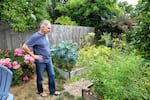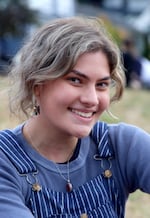
Vaux's swifts fly down the chimney at dusk at Chapman Elementary School in Portland, Ore., in this provided photo from 2022.
Tara Lemezis / Courtesy of Portland Audubon
The tiny Vaux’s swifts, birds that put on a magnificent aerial display in Portland every September, arrived early this year.
They’re already numbering in the thousands, when they’d usually only be in the hundreds. And that’s prompting concerns about the impact of climate change.
The swifts arrive in the Pacific Northwest every spring to breed. They’re dark, narrow-winged birds that usually use a hollow tree in which to make a nest.
But each fall in Portland, some preparing for their annual migration to Central America use the big chimney at Chapman Elementary School in Northwest Portland as a drier, warmer option.
“When you have a large flock of birds there’s a stronger ability for them to be vigilant and look out for predators,” said Joe Liebezeit, an assistant director of statewide conservation with Portland Audubon.

Conservationist Joe Liebezeit in his garden in Portland, Ore., Aug. 29, 2023. Liebezeit says Vaux's swifts are arriving in town earlier than usual.
Kristian Foden-Vencil / OPB
The flocking behavior provides a wonderful spectacle. The birds swoop and dive, creating beautiful patterns in the sky. At dusk, they form a spinning tornado as each one dives into the school chimney to roost.
“You can also have Cooper’s hawks and peregrine falcons show up and pick off swifts,” Liebezeit said. “The crowd that’s watching, sometimes as many as 3,000 people, you can hear the hoops and hollers as the hawks take out the swifts.”
It attracts people from all over the world. But this year, some of the birds appear to have arrived early.
“I think we had 2,000 last night and maybe about the same the night before,” Liebezeit said last week.
At this time of year, the swifts usually only number in the hundreds.
Liebezeit isn’t that concerned about the early arrivals. It could be that the air quality is a little better in Portland than in other places, because of wildfires. Or it could be that there are more insects here this season.
It could also be that the birds arrived earlier this spring, so their chicks matured earlier, and thus they’re ready to migrate earlier.
Liebezeit said climate change may play a role, but the science hasn’t been done on these particular swifts.
“Birds are shifting their ranges northwards and that’s correlated with increasing temperature,” he said.
Shifting migration patterns can be a concern as there’s no guarantee that if the swifts migrate early, for example, that there will be an early insect population to sustain them.

Abby Mankin visited Chapman Elementary School in Portland, Ore., Aug. 29, 2023, with her family to watch Vaux's swifts roost in the school's old chimney.
Kristian Foden-Vencil / OPB
On a recent evening, college student Abby Mankin sat on the grass at Chapman Elementary with her family, watching the display.
“I always wondered how they could all fit inside the chimney,” she said. “Or how they know it’s the same one each day?”
She finds their early arrival a little disconcerting.
“The birds don’t have calendars, so they have no idea when their month of September starts. So they’re just going off the air and what they’re noticing around them,” Mankin said.
“If the seasons become skewed because of climate change, the birds will be a little bit confused.”
Swifts aren’t the only birds changing their behavior. A type of flycatcher, the black phoebe, used to be rare in Portland. Now keen observers can spot them here. They’re smaller than a robin, but bigger than a house sparrow, and they have sooty black bodies with crisp white bellies.
“They often sit on a perch and fly out and grab an insect and come back to that perch or a perch nearby,” Liebezeit said.

Spectators gather on the lawn at Chapman Elementary School in Portland, Ore., Aug. 29, 2023, to watch the Vaux's swifts. Thousands of swifts stop in Portland annually during their migration, but some of the birds have arrived earlier than usual this fall, prompting concerns about the effects of climate change.
Kristian Foden-Vencil / OPB
Portland Audubon has been counting the swifts at Chapman Elementary for at least 15 years. Volunteers use a handheld counter to check each block of 10, or 100, as they swoop into the chimney. The counts are then shared up and down the West Coast.
The Chapman display usually peaks in mid-September when as many as 15,000 birds will shack up for the evening in the chimney.
When can I see the Vaux’s swifts?
During September.
What time of day?
Arrive about an hour before sunset.
The swifts begin gathering above Chapman Elementary, 1445 NW 26th Ave., Portland, about 40 minutes before sunset. They begin to enter the chimney 10 to 30 minutes after sunset, and the tornado effect can last 10 to 20 minutes.
If it’s raining, the swifts may roost early or even spend the day in the chimney.
Allow extra time to park or take public transit. Free parking available at Montgomery Park after 5:30 p.m.
How many birds will appear?
The number varies from year to year. Portland Audubon tracks numbers on its Swift Counts page. Prior to 2004, as many as 35,000 swifts had been counted in one evening. More recently, high estimates have been around 10,000 swifts.
How long will the swifts be there?
Swifts will most likely roost at Chapman through the end of September or even early October. But numbers decrease quickly after that.
Are facilities nearby?
Public restrooms are in the northeast corner of Wallace Park.
What should I bring?
Bring something comfortable to sit on and perhaps binoculars.
Be respectful to neighbors.
Neighbors have to deal with crowds every evening during September. Be respectful. Take trash away. Drinking alcohol and smoking is illegal on school grounds.
